
MAY CONTAIN NUTS

Search Shorpy
SHORPY ART

Framed or unframed, desk size to sofa size, printed by us in Arizona and Alabama since 2007. Explore now.
Join and Share
Ad-Free Shorpy
Shorpy is funded by you. Patreon contributors get an ad-free experience.
Learn more.

Recent comments
- Lost in Toyland
- And without gloves
- If I were a blindfolded time traveler
- Smoke Consumer Also Cooks
- Oh that stove!
- Possibly still there?
- What?!?
- $100 Reward
- Freeze Frame
- Texas Flyer wanted
- Just a Year Too Soon
- WWII -- Replacing men with women at the railroad crossing.
- Yes, Icing
- You kids drive me nuts!
- NOT An Easy Job
- I wonder
- Just add window boxes
- Icing Platform?
- Indiana Harbor Belt abides
- Freezing haze
- Corrections (for those who care)
- C&NW at Nelson
- Fallen Flags
- A dangerous job made worse
- Water Stop
- Passenger trains have right of way over freights?
- Coal
- Never ceases to amaze me.
- Still chuggin' (in model form)
- Great shot
Member Photos
The Shorpy
Print Emporium
Print Emporium
Search Shorpy
Search results -- 30 results per page
- Kiewel Beer: 1940
- ... View Larger Map
Barren Once again, like the Chicago photo, few people and an angle chosen that makes it seem that you're ... Posted by Dave - 11/16/2011 - 11:45am -
![Kiewel Beer: 1940 October 1940. "Grand Forks, North Dakota." 35mm nitrate negative by John Vachon for the Farm Security Administration. View full size.
A different use for grainInstead of selling beer, that location is home to a bakery. The Dotty Dunn hat store was at 17 N. 3rd Street. It, the bar and the dry cleaners are all gone, even the cut rate store to the left. The only building that survives is the one to the extreme right. Which appears to have a barber shop. BTW, Dotty Dunn Hats was a chain store operation.
View Larger Map
BarrenOnce again, like the Chicago photo, few people and an angle chosen that makes it seem that you're looking down on a detailed area of a really cool O-gauge layout. Perhaps that's what Vachon was trying to capture.
Bull City Boy has a great question, what is that automobile? A totally different look from the others. I haven't clue alas, [Lincoln Zephyr?] but now I gotta find out. What is it?
Anywhere, U.S.A.Nostalgic picture which is so similar to the small town in which I grew up but on the East Coast. Our businesses on Main Street (with the same kind of diagonal parking before meters) were Carroll Cut Rate, Adam's Hats,Gene's Bar featuring Rheingold beer, Pete's Barber Shop and Bashura's Shoe Repair. I used to love the fumes in the shoemakers and cleaners, both now deemed very lethal, i.e. shoe polish, glues, leather-tanning chemicals and carbon tetrachloride. We also had a Hart's Five and Dime and a First National grocery. Kind of neat to think that whether you grew up in the East or Midwest, the small town Main Streets were so similar.
Brew NotesAs a side note, Kiewel's Beer was brewed in Little Falls, Minnesota, while Heileman's Old Style (hanging sign over the tavern door) was brewed in La Crosse, Wisconsin.
Interior HingesSo, is no one going to identify the autos, especially the fourth from the left?
P.S. I've been away for five weeks. Glad to be back and I'll be catching up with Shorpy as best I can.
Inflation$1.98 in 1940 would be about $32 today. Not a bad price for a man's hat.
Cars ID'dFrom left,
1940 Chevy with deluxe rear center guard.
1937-38 Chrysler
1937 Nash
1939 Chrysler?
1940 Oldsmobile
Comments welcome.
The vehicle 4th from the left is a 1939 Ford Deluxe 2 door sedan. Better later than never.
(The Gallery, Cars, Trucks, Buses, John Vachon)](https://www.shorpy.com/files/images/SHORPY_8a32539a.thumbnail.jpg)
- The Big Apple: 1912
- ... burned down in a spectacular fire on January 9, 1912; the Chicago architecture firm of Graham, Burnham & Co. designed its ... Posted by Dave - 07/18/2012 - 6:56pm -
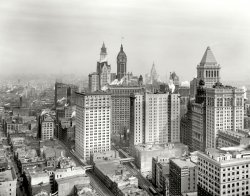
- Leonard Nimoy: 1931-2015
- ... to be present at a performance at the Schubert Theater in Chicago where I saw him play the role of Sherlock Holmes. His line "Women are ... Posted by Dave - 02/27/2015 - 9:29pm -
![Leonard Nimoy: 1931-2015 Leonard Nimoy, the sonorous, gaunt-faced actor who won a worshipful global following as Mr. Spock, the resolutely logical human-alien first officer of the Starship Enterprise in the television and movie juggernaut “Star Trek,” died Friday morning at his home in the Bel Air section of Los Angeles. He was 83.
-- New York Times
Los Angeles, 1968. "Actor Leonard Nimoy working on the set of the television show Star Trek." 35mm negative from photos by Douglas Jones for Look magazine. View full size.
One of the bestLeonard Nimoy's other work sometimes gets ignored, but all he did, both as a director and actor, he did well. There never will be another Spock, no matter how hard they try. I just wish I could have learned The Vulcan Nerve Pinch, there are people I would have gladly used it on.
Live Long and ProsperHe did, just wish it would have been longer. Time to break out the DVDs again.
[Also on Netflix streaming. - Dave]
83He did indeed live long, and he prospered.
Thrusters on FullLeonard Nimoy was a gifted actor and director and I mourn his passing with millions of others. I think it will be a long time before I can watch Star Trek II: The Wrath of Khan again.
The logic of logicI just had this thought: I bet Dave has posted a picture of Nimoy on Shorpy. Never disappointed...
"It is curious how often you humans manage to obtain that which you do not want."
--Mr. Spock Star Trek: The Original Series, "Errand of Mercy"
A One Man ShowMy wife and I went to see him years ago as Van Gough's brother in his one man show. We left the theater feeling as if we had just seen Vincent's actual brother.
What an actor and what a man to actually meet everyone that came to the theater after the show.
He was indeed 'The most beautiful...human, I have ever known'
Life long NimoyBesides the Star Trek role that I loved, Nimoy has filled this nerdy (old) boy with countless documentary narration and the series In Search Of... . Although he lived a long life I wish there was more and I'm grateful for what he created.
Go boldly, Sir.You will be missed. You taught us about logic and feelings, and the confusion that results when they collide. We learned not to fear those who looked a bit different from the rest of us. Thank you.
As a 15-year-oldI was one of the hordes that wrote NBC not to cancel the series and was shocked that it actually saved it for one more year. There was no one like Mr. Spock and never will be. Bravo Leonard!
Nimoy from Dorchester, MassAlthough about 10 years younger, my mother grew up in Dorchester, MA not far from the Nimoys. My father grew up in nearby Roxbury where he occassionally went to Leonard's father's barber shop which I believe was in Dorchester. I know there are a lot of fellow Bostonians who follow Shorpy.com. Anyone know where that shop was?
Barber shopThe barber shop where Nimoy's father Max once worked is at 1186 Blue Hill Ave. near Morton Street, in Dorchester. This photo of the late actor was taken in front of it, and posted on the Mattapan United Facebook page in 2011.
A Truly remarkable PresenceI was lucky enough to be present at a performance at the Schubert Theater in Chicago where I saw him play the role of Sherlock Holmes. His line "Women are so...illogical" stopped the show!
He was not only Spock!We had the pleasure of watching Mr. Nimoy in London (on a visit) in "Sherlock Holmes" - a play (resurrected) by the Royal Shakespeare Company. He played the part straight, and very well - until he turned to the audience, and said "But love is a human emotion" (or something close). The audience roared...
A fond memory.
(LOOK, TV)](https://www.shorpy.com/files/images/SHORPY-00790u.thumbnail.jpg)
- A Case of the Mondays: 1925
- ... of the envelopes on her desk reads Oak Flooring Bureau, Chicago. It's hard to say whether the stamps are cancelled, though, so we can't ... down in the in box is from the Oak Flooring Bureau in Chicago.
They're authors of "The Story of Oak Floors" (1924), a 24-page ... Posted by Dave - 06/25/2014 - 9:00am -
![A Case of the Mondays: 1925 There's no caption for this yellowing print of a lady at an office desk with postage stamps (quite possibly on October 19, 1925). Yet there must be some reason it's in the Library of Congress Prints & Photographs Online Catalog. View full size.
Belle Case La Follette?She looks surprisingly like Bob La Follette's widow, at least from this picture taken the year before:
[edit] OK, that settles it - they're wearing the same brooch.
Oak Flooring BureauThe return address on one of the envelopes on her desk reads Oak Flooring Bureau, Chicago. It's hard to say whether the stamps are cancelled, though, so we can't say whether the mail is outgoing or incoming and thus whether this photo shows the offices of the O.F.B.
[The condition of the envelope's edge seems to suggest one that has passed through the mail stream, or at least is not fresh out of the box. -tterrace]
Perhaps not postage stampsI think that the stamps may some sort of "Easter Seal" type of stamp, perhaps placed over the flap of the envelope to help seal it. Postage stamps at the time, if they came in sheets, had margins on each side, one of which would have had a plate number. Even if removed, the margins would have left a perforated edge instead of the straight edge shown here. They look like modern peel and stick stamps, by the Post Office didn't make those back then.
[I was thinking the same thing, not only about the absence of margins (technically, selvage), but from what I can make out of the stamp design, which doesn't seem to resemble any US stamps then in common use. -tterrace]
It has something to do with Wisconsin.She has a calendar from a Milwaukee firm, and a copy of The Political Philosophy of Robert M. LaFollette (published 1920).
Oak FlooringThe second letter down in the in box is from the Oak Flooring Bureau in Chicago.
They're authors of "The Story of Oak Floors" (1924), a 24-page book.
Fighting BobThe partly obscured book behind the telephone appears to be something about Robert "Fighting Bob" La Follette, the famous Senator from Wisconsin and champion of the Progressive political movement. He ran for president in 1924 and died just a few months prior to the apparent date of this photo.
Coupled with the calendar from the Milwaukee insurance company, I'd say the book is pretty good evidence that this picture was taken in the Badger State.
[Is it a clue as to who the lady might be? - Dave]
Christmas seals?Those look like the 1925 Christmas seals put out by the National Tuberculosis Association.
Re: Oak Flooring BureauI am enjoying this discussion of stamps and Easter Seals, with tterrace’s observations and notes, and Dave’s hint of information yet to come (or to be teased out). I would like to add that I agree with tterrace on the OFB letter being incoming as opposed to outgoing. There is a visible postmark, square in shape, across the stamp closest to the envelope’s corner.
Belle Case La FolletteI agree with the comment about this likely being a picture of Robert M. La Follette's widow, Belle Case La Follette. An interesting feature is the framed copy of Rudyard Kipling's poem "IF" on the wall behind her.
Miss-StampedI'm fairly certain the correct seal (stamp?) has not been identified. The seals on the desk in the photograph appear to lack the "Merry Christmas and Good Health" wording. There is also much more white (or light colored) area in the stamps she is utilizing than in the 1925 Christmas Seal stamp in the example below.
Could this be a Wisconsin Anti-Tuberculosis Association seal or other Wisconsin related seal?
It also seems very early in the year for this to be a 1925 "Christmas Seal." Weren't these actually sold starting around the middle of November and closer to when Christmas cards would be available? The availability of the 1925 national Christmas Seal stamp on October 19th seems doubtful (if that is the actual date of the photo).
(The Gallery, The Office)](https://www.shorpy.com/files/images/SHORPY-05720u.thumbnail.jpg)
- Steel Wheels: 1942
- November 1942. "Chicago. In the locomotive repair shops at an Illinois Central Railroad yard." ... to restore the tread and flange profile.
(The Gallery, Chicago, Jack Delano, Railroads) ... Posted by Dave - 10/28/2013 - 11:31am -
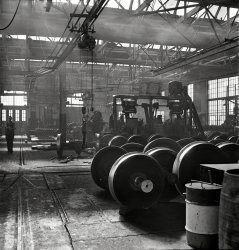
- Zany Puppets: 1955
- ... one or two in the house in La Grange, 20 miles (?) west of Chicago back then.
I was able to use the skates when other sibs were not ... Posted by Dave - 01/08/2016 - 7:07pm -
![Zany Puppets: 1955 Columbus, Ga., circa 1955. "Toys for Christmas." Starring Zany Puppets, a Transogram "Disneyland" board game, Patrician phonograph, Permoplast clay and "Trophy Hunt" target game. 4x5 negative from the News Archive. View full size.
Giving You the Evil EyeThere is something really strange about that model's eyes. Can't imagine News Photo used this shot for the final ad.
[Photos in the News Photo Archive were taken for newspaper articles, not ads. - Dave]
Trophy HuntI had that as a kid. A cogged-wheel/ratchet where the hammer could be rotated and 6 rubberbands hooked between that and the front of the gun.
Presto! You had a 6-shooter to annoy your little sister with. Forget the targets, they were lame.
SparkieAnd aenthal thinks the model's eyes are strange. I really don't like this hand puppet at all. But I do remember the smell of that kind of plastic.
Trophy HuntThanks for jogging the memory, John Howard. My brother and I had welts all over the place from these pistols.
Pretty Good Christmas Morning HaulFor a boy anyway. But can you imagine finding all those puppets under the tree!
Too young to cussIf I tried them now, cussing would definitely be involved.
Those skates bring back some unpleasant memories for me. How I made it through childhood without a broken ankle using those things amazes me. They would detach from the shoe almost every time I hit a raised seam in the sidewalk.
$50.00 worth?I realize that 1955 incomes and expenses were a small fraction of what they are today, but I believe that at the time you could buy everything in this picture for about $50. If you've looked at toy catalogs and TV ads today, toy manufacturers think nothing of putting prices on their individual toys of $100.00 and up, even more on some electronics and computer novelties (that is what I paid for a single toy Unicorn for my little grand daughter at Christmas).
Mystery modelThe model looks familiar, like a TV actress. I wonder who it was? Also, given that her eyes are nearly closed (like she blinked), I'm guessing this particular shot didn't make it into the paper.
I know this is going to hurtI remember the puppets, and know we had one or two in the house in La Grange, 20 miles (?) west of Chicago back then.
I was able to use the skates when other sibs were not using them, and to this day remember KNOWING it was going to hurt when I fell backwards to thunk my pumpkin on the concrete. It did. Made a scary sound, too. The skate wheels on the concrete vibrated as the wheels went over the finished surface with its small imperfections. Your feet would tingle as you skated, and for a while after you took the skates off. You would also have trouble walking normally for a bit without wheels. Shoes just didn't roll as well.
There was always a 'kerchunk' when you rode over the anti-crack grooves every 3 feet or so. It helped to have one foot ahead of the other and transfer weight to that foot as you passed over. I don't remember the name 60 years on, but the contractor that put in the sidewalks embedded his company name and the date (1923?) at the end of each section of sidewalk.
I may still have a skate key around here somewhere.
Lo-Fi PhonographThe Patrician phonograph was acoustic, not electronic. It only used electricity to turn the record, not to amplify the sound.
What a ShameWe don't see the word "ZANY" so much any more...of course, we don't see those puppets either - except maybe on "The Simpsons."
Zany puppetOh wow, I had the puppet she is holding. I too remember the smell of the plastic the puppet heads were made of.
(The Gallery, Christmas, Columbus, Ga., News Photo Archive)](https://www.shorpy.com/files/images/SHORPY-852.thumbnail.jpg)
- Baby Doll: 1917
- ... half a sweater done riding the rails between New York and Chicago.
Even the familiarity with which Frances holds her needles points ... Posted by Dave - 11/28/2012 - 6:28pm -
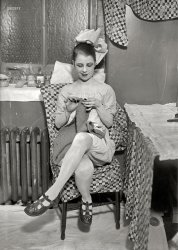
- Guggenheim Going Up: 1957
- ... a long and tortuous journey that would eventually lead to Chicago.
In the mid-1980s, Henken donated fragments of the house to public ... Posted by Dave - 04/04/2013 - 1:44pm -
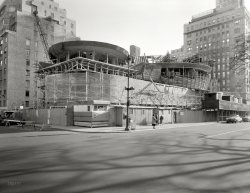
- Corner Pocket: 1918
- ... work in New York, will be married to Nate Salsbury of Chicago on Aug. 2, at the home of her parents, the Rev. Dr. Mussey of the ... brother. Mr. Salsbury is connected with Marshall Field in Chicago, where the couple are to reside."
Sharkbite! Is that thumb ... Posted by Dave - 11/15/2008 - 2:44am -
![Corner Pocket: 1918 June 22, 1918, in or near New York City. "Miss May Schloss at canteen." 5x7 glass negative, George Grantham Bain Collection. View full size.
The Hustleress"I'm really not very good... my brothers tried to teach me... I just knock the balls around most of the time... Oh, a bet? You mean for money? Oh I don't think so... well, I guess we could..."
She's played the game beforeHer left-hand's held in a pretty good bridge, she's down over her cue. I'd say she knows what she's doing. They're obviously not playing eight-ball. Could be some form of rotation since only the high balls are left on the table, or maybe straight pool.
The Original GumpThat would be a rendering of Andy Gump on the blackboard.
http://lambiek.net/artists/s/smith_sidney.htm
Navy has better tailors.Navy was better dressed than Army in 1918, too. Some things are constant through the ages.
Chalk TalkSay, anyone have a clue what's the last word above those cartoon military guys..."Before the Black S...."? Must have something with the 10 days bread and water, but I couldn't figure it out.
["Before the black slave" (there was the infantry). - Dave]
Mrs. SalsburyFrom the New York Times, July 27, 1919:
"Miss May Schloss, daughter of Mr. and Mrs. Henry W. Schloss of 156 West Seventy-fifth Street, who has been prominent in war camp community work in New York, will be married to Nate Salsbury of Chicago on Aug. 2, at the home of her parents, the Rev. Dr. Mussey of the Ethical Culture Society to officiate. Mrs. William H. Schloss, a sister-in-law of the bride-elect, is to be her only attendant. Captain Milton Salsbury is to act as best man for his brother. Mr. Salsbury is connected with Marshall Field in Chicago, where the couple are to reside."
Sharkbite!Is that thumb legal?
Nate Jr. and MiltonWere the sons of Nate Salsbury, owner and manager of Buffalo Bill's Wild West Show. In a matter of minutes I found a photo of Nate Jr and Milton as infants and other photos of their Dad with the stars of the Wild West Show. (Gotta love the Internet!)
New York Times, May 10, 1924, pg 21: "Dissolution Notice": "The co-partnership of Freedman-Salsbury Co., composed of Benjamin H Freedman and Milton S. Salsbury, and also doing business as the Herkules Saw Sales Co. of America with address at 233 Broadway, New York City, has been dissolved." - Milton S Salsbury (Milton Salsbury was the son of Buffalo Bills manager Nathan "Nate" Salsbury.)
Another interesting note -- This Benjamin Freedman tried to blackmail Woodrow Wilson.
Who knew a kooky photo of people playing pool would yield
so much?
(The Gallery, G.G. Bain, WWI)](https://www.shorpy.com/files/images/27137u.thumbnail.jpg)
- Delicious Tasty Waffles: 1939
- ... in names Plus the Blackstone Hotel, sharing the name of Chicago's headquarters of the "smoke-filled room". Pretty much unchanged in ... Posted by Dave - 04/22/2021 - 12:01am -
![Delicious Tasty Waffles: 1939 The Times Square Cafeteria, William Penn Hotel and Washington Avenue -- all located far south of their namesakes, in Miami Beach.
April 1939. "One of Miami's streets showing varied small shops, signs, and tourist bureaus. Miami Beach, Florida." Acetate negative by Marion Post Wolcott. View full size.
What's in namesPlus the Blackstone Hotel, sharing the name of Chicago's headquarters of the "smoke-filled room". Pretty much unchanged in appearance, the Miami Blackstone is now apartments.
My favorite, the Havana Tours/Greyhound Bus sign calls up images of a very wet 90-mile trip.
1D1565 1939 Oldsmobile Series 60 sedan.
http://classiccarcatalogue.com/OLDSMOBILE_1939.html
The Canadian-manufactured 1939 Pontiac (Series 25) Chieftain was almost identical
to the low-price field F39 Sixty Olds, except for the grille and some other exterior trim pieces. I sold mine two years ago.
+80Below is the same view from June of 2019.
Havana ToursDon't miss that last Greyhound back to Miami.
How times changeMy mom, born in the Bronx in 1925, lived in Miami in her late teens and early twenties. This photo is the Miami she remembered when she and my stepdad decided we should move there from Maryland in 1973. Lots of things changed during those 25 years.
[1973 is when my parents decided we should *leave* Miami. - Dave]
HousedressesThose 1939 ladies with the dog could easily have been my 1960s mother in those comfy cotton dresses; the only difference would be my mom would be in sandals or flip-flops. Same "pocketbooks" and same tightly curled hair.
The lack of parking hasn't changed.My father's family came to Miami in 1919, my mom's family in 1940. She told me in the summer time you could shoot a cannon down Lincoln Road sidewalk and not hit anybody. Before air conditioning, South Florida was very seasonal. I see they have 30 minute parking even back then. Not many people know but South Miami Beach was at one time a huge avocado grove. The little canal that connects Indian Creek was dug to transport avocados to boats that could not come to shore because of the shallow water. My dad knew people who hunted rabbits on South Beach.
Photos from that eraboth interior and exterior have that special bright glow in them that I am fond of.
Piggly WigglyI loved seeing the Piggly Wiggly sign; it brought back pleasant memories of younger days. There were a couple in my college town until as recently as 2009, when all their Texas stores closed due to a franchiser bankruptcy.
Despite the funny name, they are also known for being the first self-service grocery store, founded in 1916.
(The Gallery, Eateries & Bars, Florida, M.P. Wolcott, Miami, Stores & Markets)](https://www.shorpy.com/files/images/SHORPY-8c09804a.thumbnail.jpg)
- The Hot Seat: 1939
- ... missing. My wife and I lived at Lincoln and Armitage in Chicago in the 1980s and used to go to the original (pre-franchise) Potbelly ... Posted by Dave - 01/17/2018 - 6:46pm -
![The Hot Seat: 1939 October 1939. "Farmer sits near the stove. General store in Lamoille, Iowa." Photo by Arthur Rothstein for the Farm Security Administration. View full size.
Gives Appetite to AllThe healthy baking powder.
Brands you can buy todayClabber Girl
Copenhagen
Dr. Pepper
Kellog's All-Bran
Kotex
Pepsi
Modess
Wheaties
Maca YeastA new fast dry yeast.
ModessFrom a 1928 Ladies Home Journal:
“In order that Modess may be obtained in a crowded store without embarrassment or discussion, Johnson & Johnson devised the Silent Purchase Coupon presented below. Simply cut it out and hand it to the sales person. You will receive one box of Modess. Could anything be easier?”
More here:
https://www.kilmerhouse.com/2008/02/the-product-that-dared-not-speak-its...
[Or you can stock it next to the Wheaties, and hope for the best. - Dave]
Brands You Can Buy Today, Vol. 2Don't forget Kix, between the All-Bran and the Heinz product du jour, and of course Ivory Soap, proudly displaying its uncanny ability to float to the top.
LOOK!The hands of that farmer speak volumes!
Dowagiac Round OakThe Round Oak stove that dominates the photograph was the product of a company that only had a few more years to live. The Estate of P.D. Beckwith, Inc. produced wood stoves in their hometown of Dowagiac, Michigan from 1871 to 1946 or '47, when they sold the buildings to Kaiser-Frazer automobiles and the Round Oak name to Peerless Furnace. Founder Philo Beckwith died in 1889, and the company name was officially changed from Round Oak Stove Company to The Estate of P.D. Beckwith, Inc. about 1890.
Round Oak stoves were quite efficient for their time and very popular, and at one point employed more than 20% of Dowagiac's population.
Farms consolidateSurprisingly, Iowa was the 10th most populous state in the 1900 census. As farms consolidated in size and as cities grew, it slid down the rankings every decade since then. In 1940 (a year after this photo) it was the 20th most populated; today it is about the 30th.
Not just Round Oak... but quarter-sawn, as well. Wonderful chair he's sitting in!
My local Potbelly Sandwich Shop has the same stoveOr most of it. Some of the parts are missing. My wife and I lived at Lincoln and Armitage in Chicago in the 1980s and used to go to the original (pre-franchise) Potbelly restaurant, which is still in business there.
Pepsi-Cola hits the spot... 12 full ounces, that's a lot! Or you could have Dr Pepper at 10, 2 and 4!
"Modess--Because"This was how this product was discreetly advertised in women's magazines back in the 1950s-early 1960s. It was the caption to a photo of a beautiful woman, dressed in an elegant ballgown, usually standing on a mansion terrace overlooking the French Riviera at night. At age 5, I didn't know what Modess was, but when I grew up, I wanted to be that lady!
(The Gallery, Arthur Rothstein, Small Towns, Stores & Markets)](https://www.shorpy.com/files/images/SHORPY-8b19034a.thumbnail.jpg)
- Klesken Cleans Up: 1943
- April 1943. Proviso Yards of the Chicago & North Western Railroad. Joseph Klesken washing up after a day's ... Office of War Information.
(The Gallery, Kodachromes, Chicago, Jack Delano, Railroads) ... Posted by Dave - 08/30/2012 - 3:30pm -
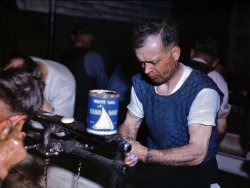
- Belt Line Caboose: 1943
- ... operations on the Indiana Harbor Belt railroad between Chicago and Hammond, Indiana. Belt Line cabooses never go long distances or at ... Posted by Dave - 10/13/2013 - 5:00pm -
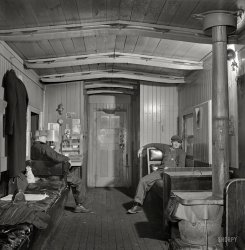
- Social Study: 1941
- April 1941. "Children playing on the street. Chicago, Illinois." 35mm negative by Edwin Rosskam for the Resettlement ... ...to identify THIS location?
(The Gallery, Chicago, Edwin Rosskam, Kids) ... Posted by Dave - 05/28/2014 - 3:30pm -
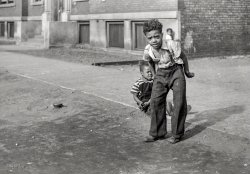
- Railfan: 1924
- ... five examples of this 1919 locomotive were built for the Chicago Milwaukee St. Paul and Pacific Railroad. At the time of this ... is being conducted by the General Electric Company and the Chicago, Milwaukee and St. Paul Railway.
Walter C. Marshall, electrical ... Posted by Dave - 09/12/2011 - 11:43am -
![Railfan: 1924 June 1924. "Largest electric locomotive and Congressman John C. Schafer." It's that train-lovin' lawmaker from Wisconsin again, this time with a new ride. National Photo Company Collection glass negative. View full size.
Based on the shape of the cowlThis appears to be a Milwaukee Road "Bipolar". There's one preserved, in St. Louis.
Milw BipolarThat is correct. The 5 EP-2 General Electric locomotives continued to serve until the early 1960's. Note the pneumatic bell on the top of the carbody.
What Railroad?What RR owned the bipolar in the DC area?
[As noted in the "bipolar" comment, the Milwaukee Road. - Dave]
PowerlessOddly enough, the pantograph appears to be raised, but there's no sign of any overhead catenary here or nearby. As these engines were built for use on the electrified west end of the Milwaukee, is there any clue as to the location?
[This is near Union Station in Washington. - Dave]
One of fiveThe only five examples of this 1919 locomotive were built for the Chicago Milwaukee St. Paul and Pacific Railroad. At the time of this photograph the Pennsylvania Railroad had not yet installed electrification into Washington, D.C. (which began service in 1935). Perhaps this locomotive was visiting in order to stimulate interest in the future plans.
Locomotive to Be ShownWashington Post, June 22, 1924.
Locomotive to Be Shown
Largest and Most Powerful Electric Engine
To Be Shown Here.
The largest and most powerful electric locomotive in the world will be displayed in Washington Wednesday and Thursday of this week, it was learned yesterday. From advance information, it was learned that the locomotive will be exhibited at New York and Florida avenues northeast. The exhibit is being conducted by the General Electric Company and the Chicago, Milwaukee and St. Paul Railway.
Walter C. Marshall, electrical engineer, and John T. Elliott, of the General Electric Company, will be in charge of the exhibit, pointing out to all those who wish to inspect the engine, its finer points.
Picture location The picture may have been taken at the GE plant (Erie)or in transit to the Milwaukee electrified territory, the Milwaukee used to display their new locomotives at larger cities enroute.
[The photo was taken in Washington near Union Station. - Dave]
(The Gallery, D.C., Natl Photo, Railroads)](https://www.shorpy.com/files/images/25855u.thumbnail.jpg)
- Mouquin's: 1910
- ... Mouquins were not interested in buying the painting. The Chicago Art Institute currently owns it.
(The Gallery, DPC, Eateries & ... Posted by Dave - 09/29/2015 - 11:49pm -
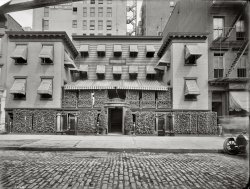
- Clown Car: 1957
- ... boasted the largest trolley coach system in the US, but Chicago had more vehicles, fewer route miles.
Boy howdy, what a photo! I ... Posted by prrvet - 03/13/2018 - 4:21pm -
![Clown Car: 1957 The Shriners' Annual Convention took place in downtown Atlanta's Peachtree Street on August 30, 1957. As a senior at Georgia Tech, I was there to photograph the action. The Loew's Grand Theatre in the background was the location of the premiere of "Gone With the Wind" in 1939. 35mm Kodachrome by William D. Volkmer. View full size.
Buick and NashThe green convertible is a 1956 Buick Special and the black car facing it is a 1949 or 1950 Nash (there were no styling changes from 1949 to 1950)
I Was Not A Teenage WerewolfBut wasn't Michael Landon?
The two for one in that small movie house includes probably one of the best B movies of the era. "Invasion of the saucer-men". I hope they bring tea or coffee with those.
[The “small” Paramount Theatre had seating for 2700. -tterrace]
CorrectionThat restored trolley coach and 139 others like it were built by St. Louis Car Company in 1949. Only one specimen was saved. Atlanta did have about 175 Pullmans some dating back to 1944. Atlanta once boasted the largest trolley coach system in the US, but Chicago had more vehicles, fewer route miles.
Boy howdy, what a photo!I saw Gone With the Wind in a theater in downtown Atlanta in the late 1950s, and I saw How the West Was Won a few years later in the Loew's, I think. We had lunch in that cafeteria, probably.
That Olds (guessing here) is a beauty, and I'm proud to have a '49 Snakehead Tele clone in that Seafoam Green nitro finish.
[Those clowns are in a 1956 Buick Special. -tterrace]
[With Florida plates. - Dave]
Man. Shorpy.com is really on a roll in 2018.
Boy howdy!!!
Edit: Thanks, tterrace and Dave for that great info!!!
If It Still Looked Like That, I'd Still Live ThereThis is the downtown Atlanta of my youth - when the buildings were beautiful, the people well-dressed, and the atmosphere civilized. From left to right, I recognize the Collier Building, where a Rexall was at street level, but the fabled Frances Virginia Tea Room occupied the top floor for many years. Next to it is the Paramount Theatre, demolished not too many years after this photo was taken; its stone was re-used for the facade of a mansion in another town. After that comes Loew's Grand, one of the bigger theatres, originally the De Give Opera House. The electric trolleys in the photo were phased out around 1962. Every building I've mentioned is gone.
Atlanta Theaters I saw "How The West Was Won" at The Martin Cinerama while seated next to Bert Parks of Miss America fame. The Cinerama was located further up Peachtree just South of The Fox theater.
Additionally, I spent my lunch hour standing across the street while Loew's Grand burned to the ground on January 30, 1978. The temps were subfreezing and icicles were everywhere.
I did a little researchand found out that one of these 1949 Pullman-Standard trolley coaches has been restored. If you want to go back in time, you may find it at the Southeastern Railway Museum.
Errare humanum estYes, my bad.
prrvet is absolutely right.
What a double-bill!I'd line up early and pay a premium price to catch I WAS A TEENAGE WEREWOLF and THE INVASION OF THE SAUCER MEN at the Paramount.
sigh...
Elvis played the ParamountGreat pic! in June of '56 Elvis played the Paramount
http://scottymoore.net/paramount.html
Peachtree ParadeOnly two months prior to this parade, Atlanta blues musician Piano Red (Willie Perryman) had released "Peachtree Parade", which had been recorded already in 1955. It's an instrumental, so basically any parade can be projected onto it.
https://www.youtube.com/watch?v=XLzg1H6OxGQ
(ShorpyBlog, Member Gallery)](https://www.shorpy.com/files/images/AtlantaTrans_1755_PeachtreeEllis_08301957WDV_1.thumbnail.jpg)
- Float Your Boat: 1905
- ... 24, 1905. "Steamer William E. Corey, the launch, South Chicago, Ill." Seen earlier here and here . 8x10 inch dry plate glass ... if it has a man's name?
(The Gallery, Boats & Bridges, Chicago, DPC) ... Posted by Dave - 09/24/2018 - 11:08am -
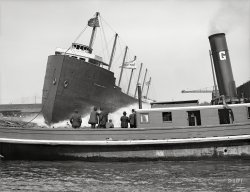
- Jacked: 1942
- November 1942. "Chicago, Illinois. Jacking up a car on the repair tracks at an Illinois Central ... Posted by Dave - 08/21/2013 - 2:19pm -
![Jacked: 1942 November 1942. "Chicago, Illinois. Jacking up a car on the repair tracks at an Illinois Central Railroad yard." Someone get the spare out of the trunk? Medium-format negative by Jack Delano, Office of War Information. View full size.
RIP: 1942Delano caught it on one of the RIP tracks. Repair In Place.
Treble MemoryI believe both wheels shared a common axe. So to make a change he needs another jack. Quiz time: why were the outer rims tapered?
[That axe never stops sharpening. - Dave]
Doh!When they told him to go get a Duff he thought they meant Beer.
Not just trucking aroundThere probably is another jack out of view to the left. He'll be removing the whole truck (both axes...er...axles and all 4 wheels). If he was just removing one pair of whhels he'd have to support the truck somehow instead of the frame of the car.
Don't Damage the FinishWe first saw a track jack and Texas toothpick back here. I don't quite understand the padding that seems to be sitting on the business end of the jack.
Tapered wheelsTapered wheels keep the wheels centered on the rails and allow for the different distances each wheel travels when going around curves since they have a solid connection via the axle to the opposite wheel. In an ideal world the flanges should never touch the rails in reality they do however.
Wheel taperWheel taper is 2 degrees 50 minutes. The taper is designed to keep the flanges off the rail heads and to eliminate hunting. The wheels are pressed onto the axles. This particular car has 33 inch wheels and plain bearings. It would be another 20 years before roller bearings were in widespread use on freight cars.
That guy has some "get up and go"Now that's what I call a faith-based initiative!
That JackThat jack is very similar to the ones my father had stored in his garage. He used a couple to jack up the front and back porches on his house (for long term stability). He called them "house" jacks, and I'm sure they are still doing their jobs 60 years after installation!
Trucks and solid axles. With the solid friction bearing axles as in this pictured truck. The truck needs to be disassembled to replace a wheel set (2 wheels and axle). The paper between the jack and steel body is to reduce slipping of the steel on steel surface.
(The Gallery, Jack Delano, Railroads)](https://www.shorpy.com/files/images/SHORPY_8d23268a.thumbnail.jpg)
- Proviso Freight House: 1943
- April 1943. "Chicago & North Western R.R. Tracks leading into the freight house at ... transparency by Jack Delano for the OWI.
(The Gallery, Chicago, Jack Delano, Railroads) ... Posted by Dave - 08/10/2012 - 5:39pm -
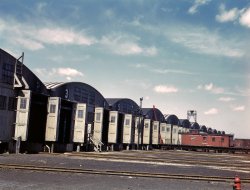
- Flight Command: 1941
- April 1941. "Movie theater. Southside, Chicago, Illinois." Medium format negative by Russell Lee for the Farm Security ... one of the greatest live albums here.
(The Gallery, Chicago, Movies, Russell Lee) ... Posted by Dave - 09/20/2018 - 11:30am -
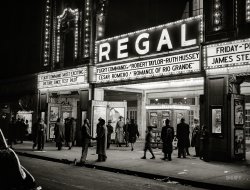
- Santa Fe Elevator: 1915
- Chicago circa 1915."The Santa Fe grain elevator, head of the canal." Pantry for ... Link here.
(The Gallery, Boats & Bridges, Chicago, DPC, Railroads) ... Posted by Dave - 04/19/2016 - 10:10am -
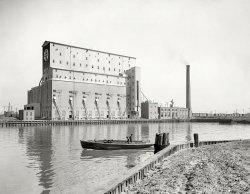
- Party Animal: 1956
- ... Misty when she left for Chincoteague.
(The Gallery, Chicago, Horses, Kids, News Photo Archive, Scary Clowns) ... Posted by Dave - 07/29/2015 - 12:40pm -
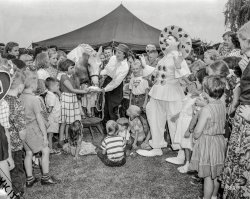
- South Side Cartman: 1941
- ... April 1941. "Man-drawn carts are common on South Side of Chicago." 35mm negative by Russell Lee for the Farm Security Administration. View full size.
(The Gallery, Chicago, Russell Lee) ... Posted by Dave - 09/09/2011 - 7:11pm -
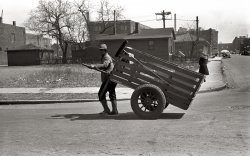
- Hank Aaron: 1934-2021
- ... my soon-to-be husband took me on our first date to see the Chicago White Sox defeat the Kansas City Royals 4-0 at old Comiskey Park, and ... Posted by Dave - 01/22/2021 - 1:43pm -
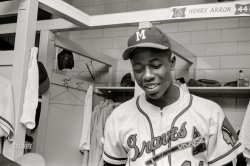
- Support the Strike: 1941
- ... increase of $8 weekly wage. Mid-City Realty Company, South Chicago, Illinois." Acetate negative by John Vachon. View full size.
... I would have expected no less of her.
(The Gallery, Chicago, John Vachon) ... Posted by Dave - 02/01/2020 - 2:44pm -
![Support the Strike: 1941 July 1941. "Girl in picket line. Union picketing for increase of $8 weekly wage. Mid-City Realty Company, South Chicago, Illinois." Acetate negative by John Vachon. View full size.
Unintentionally iconicI don't know from the strike issues but I love her outfit, her shades, her hair, and her attitude. I wish I could see her shoes.
[Et voilà! - Dave]
Thanks! Huarache pumps! Classic choice. I would have expected no less of her.
(The Gallery, Chicago, John Vachon)](https://www.shorpy.com/files/images/SHORPY-8c19551a.thumbnail.jpg)
- High Steaks: 1941
- June 1941. "Chicago, Illinois. Meat in cold storage. Davidson Meat Company, supplier of ... hamburger. I'm still a carnivore!
(The Gallery, Chicago, John Vachon, Kitchens etc.) ... Posted by Dave - 06/08/2020 - 12:09pm -
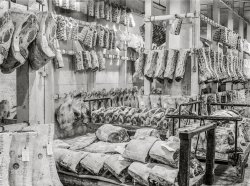
- Indigo Girl: 1943
- April 1943. "Chicago & North Western R.R. -- Mrs. Dorothy Lucke, employed as a wiper at ... Posted by Dave - 08/30/2012 - 4:48pm -
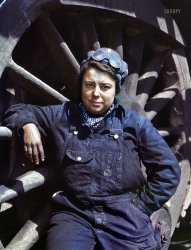
- Surrey With the Fringe on Top: 1908
- ... who give information as to "how these things are done in Chicago."
More News To Come Not yet on the island's PR band wagon but ... Posted by Dave - 07/19/2012 - 10:22pm -
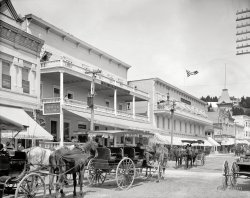
- A Sign Unto You: 1922
- ... Specifically the lighter print between "Orchestra Of Chicago" and "HEAR THEM"? I've enlarged the photo, but despite the high ... Posted by Dave - 09/13/2011 - 8:24pm -
![A Sign Unto You: 1922 New York, May 1922. "Grace Methodist Episcopal Church, West 104th Street." Gutted by a five-alarm fire in 1983. Bain News Service. View full size.
Isham JonesLeading one of the most popular bands of the 1920s and 30s, Isham Jones would have a million selling record in 1921, Wabash Blues. He retired in 1936 and Woody Herman took charge of the band.
http://www.youtube.com/watch?v=kmkxc-FA5wg
A musical churchAs a Methodist and a musician, I appreciate that this is apparently a musically enlightened church. The Isham Jones orchestra was one of the most prominent of its day, rivaling that of Paul Whiteman. Also, notice the sermon topic: From Five Flats to Two Sharps. (D-Flat Major to D Major) It would be interesting to know how he made a sermon of that material.
Not exactly an "Open Door" church.I hope nobody was trapped inside when the fire broke out with those gates in place!
Must have been a pretty hip churchto have had Isham Jones and his orchestra playing! It would have been my church for sure!
Original verbageNever have seen these words "this may be your church" on a church sign before. Kind of interesting and also the open window at one of the stained glass panels.
I suppose the large signis more effective than placing a classified ad reading" "Found. One church. If yours please call 555-1212 with a description."
My neighborhood churchWell, one of them. It is located between Columbus and Amsterdam Avenues. I walk past it at least 3 times a week, and remember that fire very well. It is now a neighborhood center-cum-church with an attached apartment building. Interesting that Isham Jones' orchestra played there. That might have gotten me to church!
A joyful noiseIt was very unusual for a dance orchestra to play in a church in those days. There was a lot of bombast against dancing and so-called jazz music.
Jones' situation was probably helped by the fact that he himself had played music in his Methodist church as a boy in Saginaw, Michigan, and that his mother was the church's organist.
Can't quite read the whole signSpecifically the lighter print between "Orchestra Of Chicago" and "HEAR THEM"? I've enlarged the photo, but despite the high resolution, that part of the sign is difficult to read. Can anyone tell me what it says? Just curious!
["One of the finest Musical Organizations in the Country, costing Brunswick Co. thousands of dollars each day they spend in N.Y. making records." - Dave]
Senate ChaplainThe Saturday New York Times of May 6, 1922 had an advertisement for the service (shown below). Presumably then the Isham Jones Orchestra played at the church on Sunday May 7.
Rev. Dr. Frederick Brown Harris was born on April 10, 1883 in Worcestershire, England, and came to the United States as a child. He was ordained a Methodist minister in 1909. After two other pastorates, he came to this church in 1918. In 1924 he became the pastor of the Foundry United Methodist Church, in Washington, D.C., where he would remain until he retired in 1955.
Rev. Harris became the Chaplain to the U.S. Senate on October 10, 1942. This lasted until January 4, 1947. After the sudden death of his successor, Rev. Peter Marshall in January 1949, Harris was again appointed U.S. Senate Chaplain. This tenure lasted from February 3, 1949 to January 9, 1969. During his life Harris conducted the funeral services for President Herbert Hoover, Senator Robert A. Taft, and General Douglas MacArthur. He died on August 18, 1970. He remains the longest serving Senate Chaplain (24 years total).
(The Gallery, G.G. Bain, NYC)](https://www.shorpy.com/files/images/34214u.thumbnail.jpg)























